It was January 28, 1077 , when Emperor Henry IV and Pope Gregory VII met at Canossa in the presence of Matilda of Canossa (Mantua, 1046 - Bondeno di Roncore, 1115): an episode that has remained in history as the greatest public repentance of all time, to which we still owe the saying “going to Canossa,” signifying an act of total submission to beg forgiveness. Henry IV had been excommunicated by Gregory VII as a result of the so-called “investiture struggle,” in which temporal power claimed to be superior to spiritual power; on the contrary, Gregory VII claimed his papal power superior to any other, as expressed in his Dictatus papae in 1075. The fulcrum of the struggle was the synod of Worms, during which Henry IV and his allied German bishops went so far as to declare the pope deposed, and the pope reacted by excommunicating him, releasing all his subjects from their oath of allegiance and desacralizing his empire. Faced with this, the German princes forced him to reconcile with the pope and set a meeting for Feb. 2, 1077, to be held in Augsburg, at which he and Pope Gregory VII were to absolve Henry IV or elect a new emperor. In December 1076 the pope departed Rome bound for Augsburg and was Matilda’s guest in the Castle of Canossa, under protection, when Henry, who had set out for Italy as soon as he learned of the journey undertaken by the pontiff, arrived just outside the gate of that castle. Matilda played the role of mediator between the two: for some time already she, the emperor’s second cousin but a devotee of the Church, together with Abbot Hugh of Cluny, had been arranging reconciliation. Henry arrived here on January 25, 1077, but had to wait three days and nights in penitent dress, barefoot, under a blizzard, outside the castle of Canossa before being received by the pope, thanks to the intercession of Matilda and the abbot of Cluny, his godfather. A solemn celebration followed by a banquet sanctioned the reconciliation.
The episode is depicted in a splendid marble altarpiece created by Carmela Adani (1899 - 1965), among the sculptors of the 20th century, inside the Regina Pacis church in Reggio Emilia. The monumental work of 1956 is placed in one of the few altars dedicated to Pope Gregory VII and depicts precisely the absolution of Henry IV, who is seen kneeling barefoot, by the pontiff, enthroned in the center, in gilded detail. Around him can be recognized Matilda of Canossa, the abbot of Cluny, along with two other pesonages. A sculptural work of great refinement as seen in the details of the accessories and clothing.
Among the most influential and powerful personalities of the Middle Ages, Countess Matilda of Canossa was able to settle (if only for a short time) one of the most significant conflicts between secular and religious power; she is still remembered as one of the female figures who made history, mistress of vast territories and protagonist of important events around which sovereigns and popes revolved.
Born in Mantua in 1046 to Boniface Canossa and Beatrice of the Dukes of Lorraine, Matilda found herself heir only in 1055 to all of her father’s feudal territories, following first the death of her father, who was killed during a hunting party, and then the untimely deaths of her sister Beatrice and brother Frederick. A vast territory, known as the Lands of Canossa, which stretched from parts of Lombardy to Viterbo, including Reggio Emilia, Modena, Parma, Ferrara, Tuscany, the duchies of Spoleto and Camerino, full of castles belonging to the Attonidi family, from which she was descended (in fact, she was also the last member of the Attonidi). Her mother, after the death of her husband, had remarried to Goffredo il Barbuto of Lower Lorraine, and Matilde had been betrothed to the latter’s son, Goffredo il Gobbo: the marriage between the two families would give rise to a vast and powerful territory that worried Emperor Henry III. For this reason he led Beatrice and Matilda to Germany, imprisoning them, while the Bearded One managed to escape. Having freed mother and daughter, who managed to return to Italy, the fight against the simoniacal clergy began in northern Italy.
 |
| 12th-century miniaturist, Hugh of Cluny, Henry IV and Matilda of Canossa, from the Vita Mathildis of Donizone of Canossa (1111-1116; miniature; Vatican City, Vatican Library, Cod. Vat. Lat. 4922, fol. 49r) |
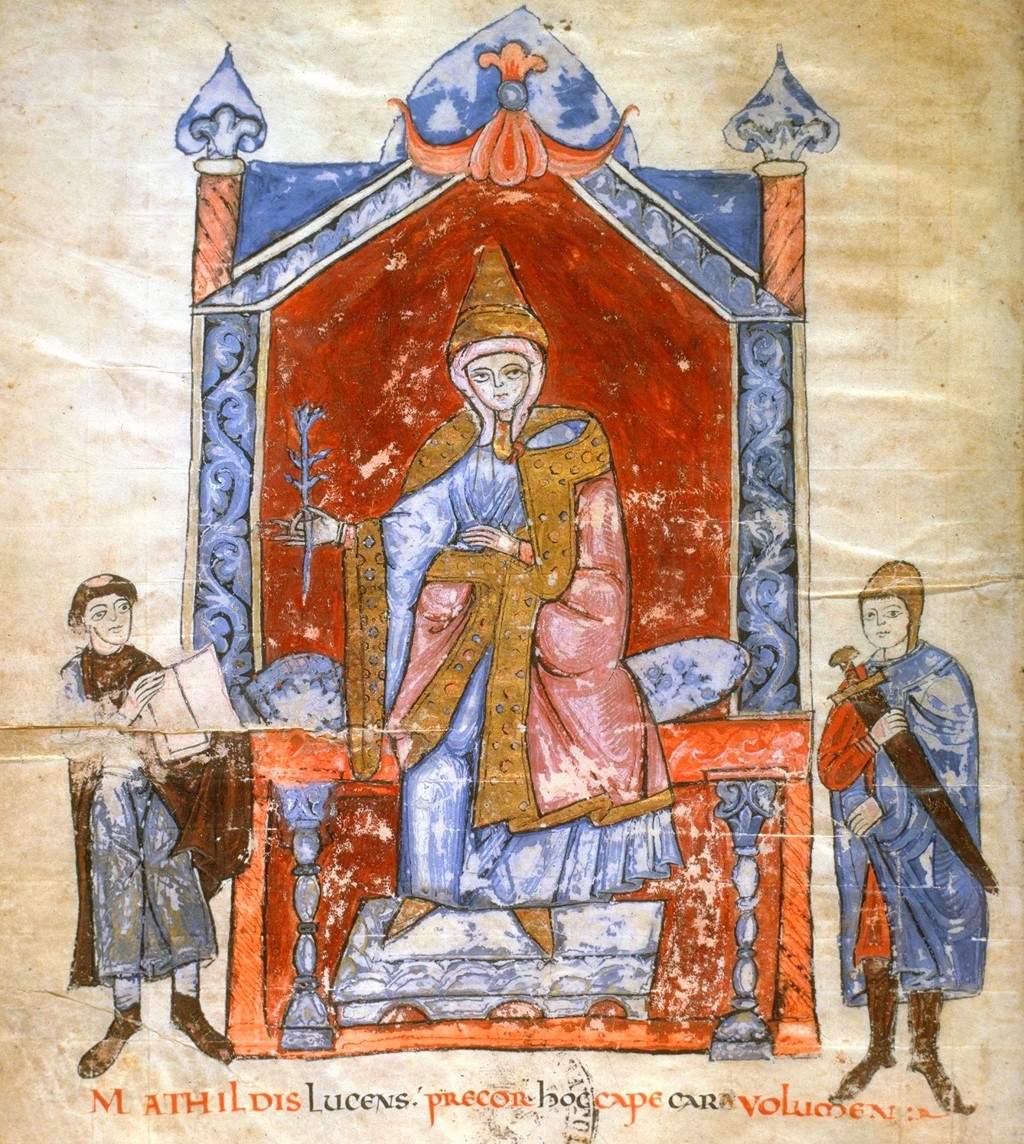 |
| 12th-century miniaturist, Matilda of Canossa enthroned, from the Vita Mathildis of Donizone of Canossa (1111-1116; miniature; Vatican City, Vatican Library, Cod. Vat. Lat. 4922, fol. 7v) |
 |
| Carmela Adani, Altarpiece of Canossa (1956; stone; Reggio Emilia, Regina Pacis). |
From 1069 Matilda moved to Lorraine, where she married Goffredo il Gobbo, but the marriage ended after only two years; in reaction to his wife’s abandonment, the Gobbo had Emperor Henry IV write a document against Matilda, which he later signed, accusing her of having amorous relations with Pope Gregory VII, born Ildebrando di Soana. Back in Italy, Matilda was present at the election of Gregory VII as pope, and the various events that led to the aforementioned humiliation of Henry IV at Canossa began from this period. Meanwhile, Godfrey the Hunchback was assassinated, and suspected as the instigator of the killing was Matilda herself. Between 1079 and 1080 the countess donated all her property to the Church and thus to the pope: Henry IV banished her from the empire, deposed Gregory VII and appointed the antipope Clement III. Matilda had her first real defeat at Volta Mantovana, rushing with her troops to confront the imperial army. After being banished to Lucca, guilty of lesa majesty imperial, the countess had her revenge at Sorbara and reconsolidated her power. In 1088 Matilda married, as advised by Pope Urban II, Guelph V of Bavaria, an enemy of Henry IV, and the union lasted seven years. Between Bianello and the Canusian fortress, Matildic troops defeated the emperor. In 1111 Matilda was crowned viceregent of the Ligurians and Lombards and appointed vicar of the empire by Henry IV’s successor, Henry V. Four years later, the countess died at Bondeno di Roncore and was buried in the monastery of San Benedetto di Polirone, and in 1632 her body was transferred to Rome, to the Vatican, at the behest of Urban VIII. A large monument in St. Peter’s Basilica, designed and built by Gian Lorenzo Bernini, still celebrates her today.
Thanks to the Vita Mathildis by Donizone, a monk and later abbot of the monastery of Sant’Apollonio di Canossa and a spiritual confidant in the last years of Matilda’s existence, descriptions and accounts of the countess’ life have come down to us. The aim of the illuminated poem, now preserved in the Vatican Library, was to convince her to choose the monastery of Sant’Apollonio as her last resting place: she preferred the monastery of San Benedetto di Polirone instead. Donizone would have liked to give her poem to Matilda, just as depicted in the miniature of the codex with Matilda enthroned, but death caught her before the volume was bound. Another famous miniature depicts her in theepisode of Henry IV’shumiliation , where the latter appears kneeling before the countess and the abbot of Cluny to obtain absolution from excommunication. The monk describes her as follows at the beginning of the second book: “She is as bright as Diana’s star is shining: / faith enlightens her, hope wraps her in a wondrous way, / and dwells in her the greatest gift, charity. / She worships the supreme Word, for whom all was created; / She loves and praises her ministers, when she finds them modest; / She obeys them reverently and honors them. / She hates vices, she knows how to exalt virtue; [...] Not good fortune exalts her, nor adversity troubles her: / in all things she shows discernment; / her fame spreads perennial through all kingdoms./ Carry the sails across the seas the echo of her deeds.” From this quotation we already grasp the characterizing aspects of her famous figure: the fact that she devoted her entire life to the politics of her territories, in particular taking an active part in the contrasts between the papacy and the empire, and her devotion, always siding with the Church and even donating all her possessions to the Holy See. In the Matildic territories, the countess is said to have built ahundred parish churches, often associated with castles: religiosity and defensive structure were in fact the dominant features of that vast territory, of which there is still evidence today, although often modified by later reconstructions, particularly in the case of the parish churches. The best-known castles linked to Matilda are those of Bianello, Canossa, Rossena and Carpineti, all in the province of Reggio Emilia.
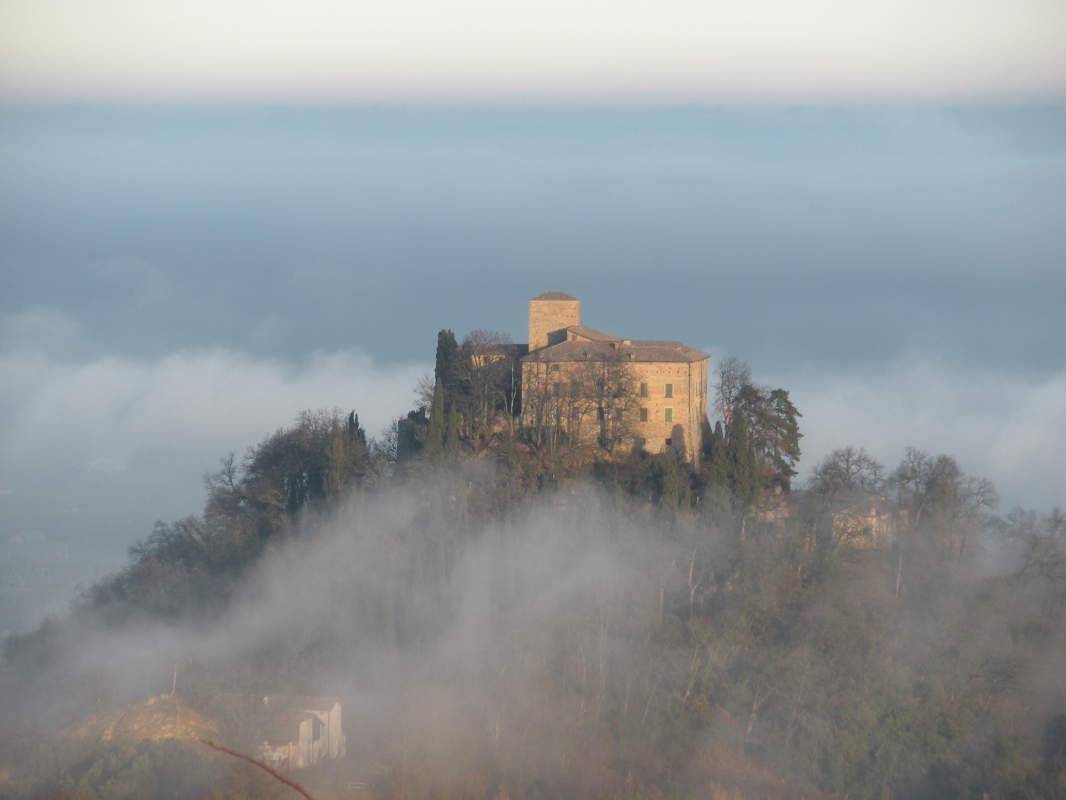 |
| The castle of Bianello. Ph. Credit Claudio Reverberi - Emilia-Romagna Regional Castles Project. |
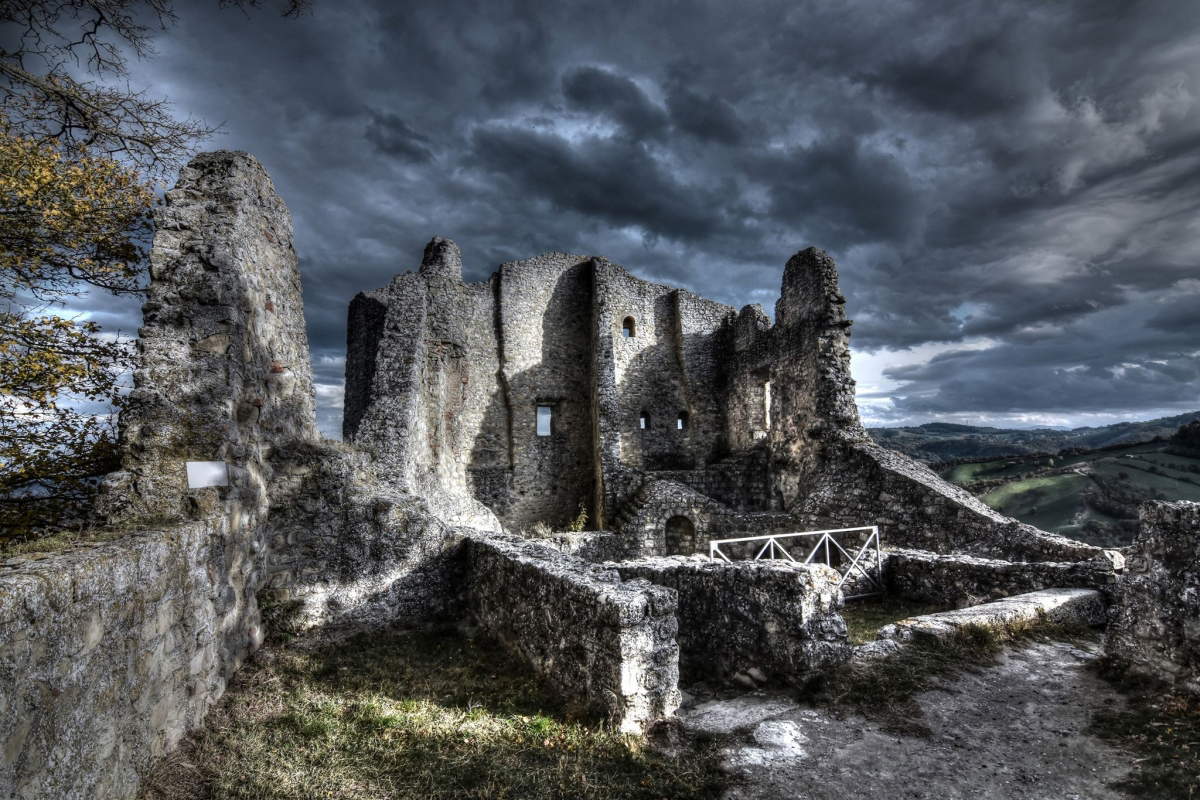 |
| The Castle of Canossa. Ph. Credit Regional Project Castles Emilia-Romagna |
 |
| The Castle of Rossena. Ph. Credit Regional Project Castles Emilia-Romagna. |
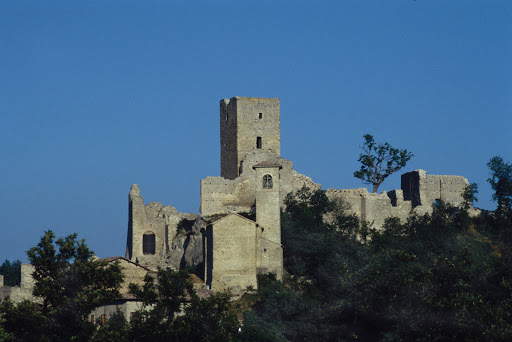 |
| The Castle of Carpineti. Ph. Credit Castle of Carpineti |
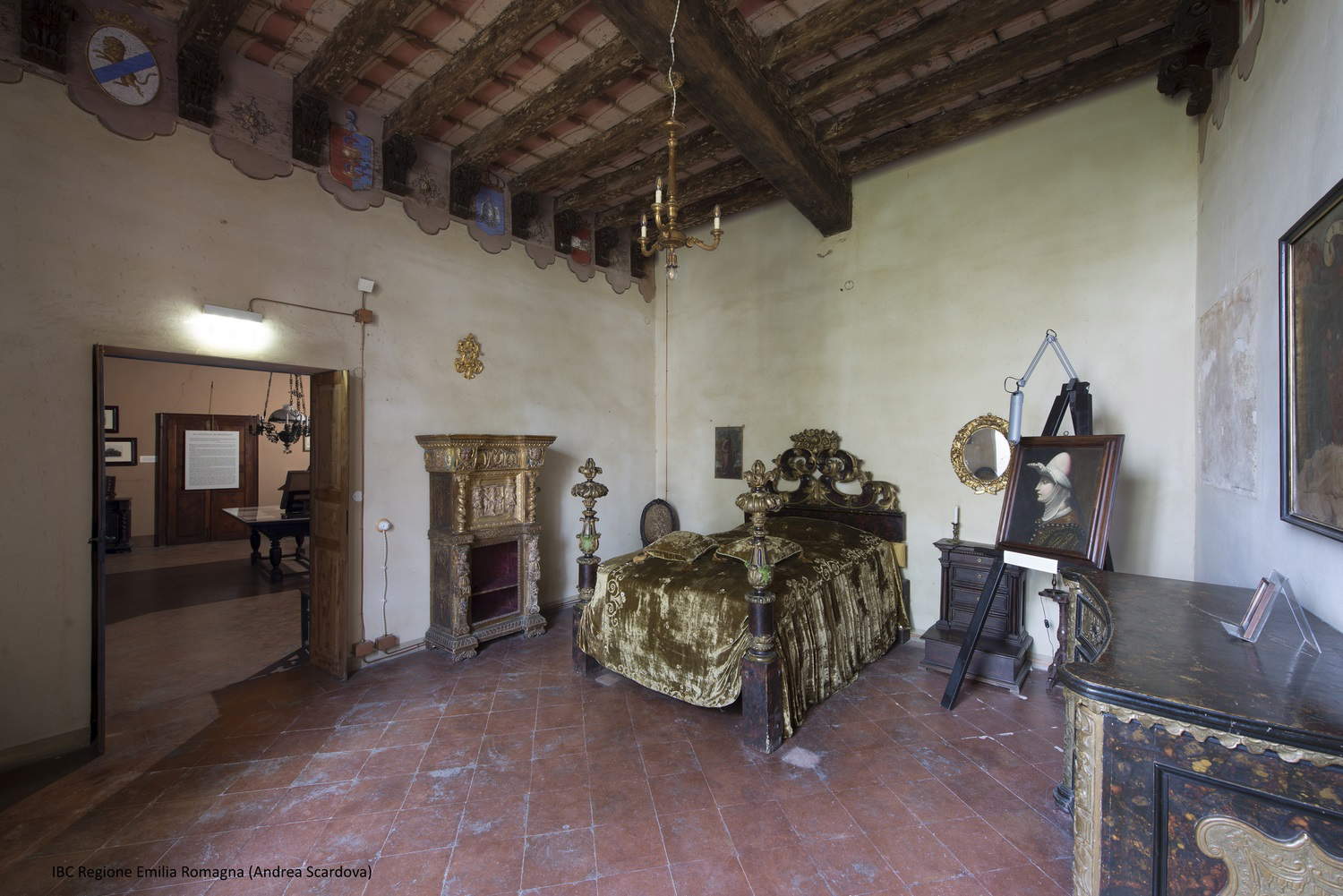 |
| A room of the Castle of Bianello. Ph. Credit IBC Emilia-Romagna |
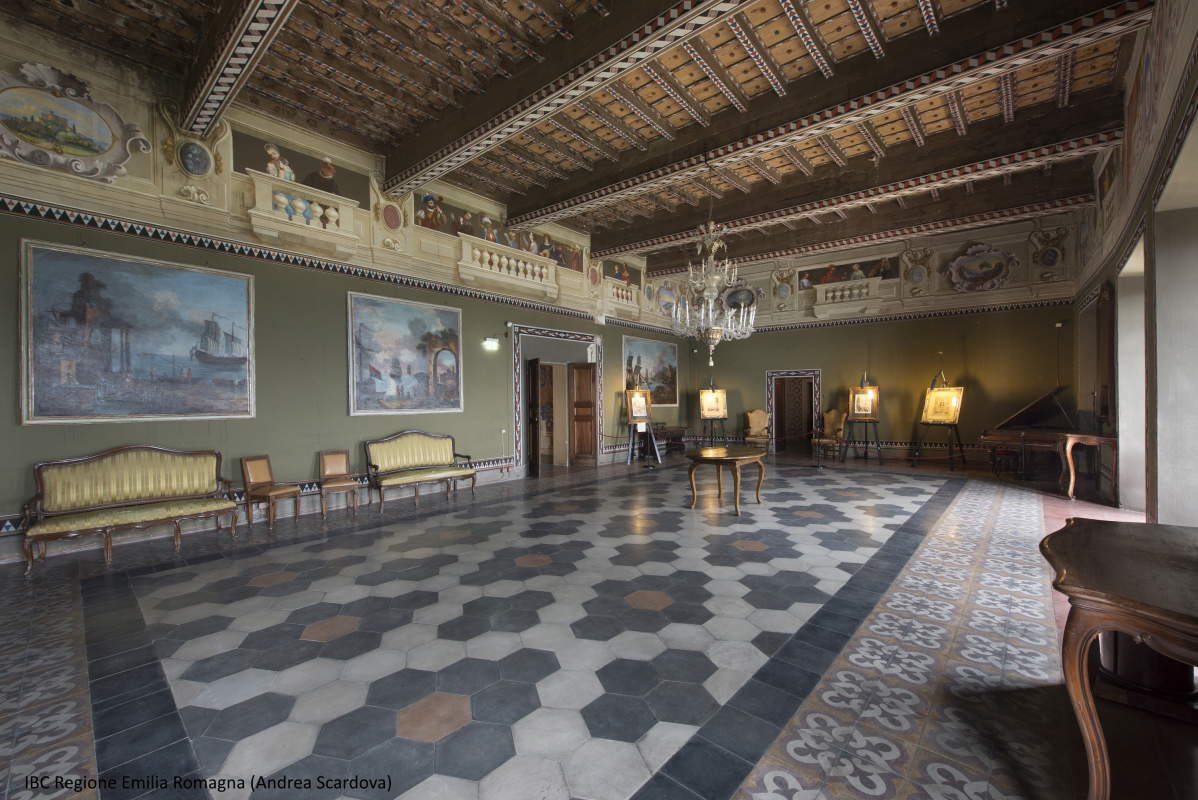 |
| A room of the Castello di Bianello. Ph. Credit IBC Emilia-Romagna |
 |
| A room of the Rossena Castle. Ph. Credit Emanuela Rabotti - Regional Project Castles Emilia-Romagna |
The castle of Bianello, still preserved intact today, stands on the hill of Bianello in the Reggio Emilia Apennines, in the locality of Quattro Castella. With a polygonal plan, the ancient fortress has a tower located on the western side articulated on five levels, which probably already existed from the first half of the 10th century as a lookout point intended for defense, but there is definite evidence from 1044; subsequently the castle underwent extensions and developments starting from the original nucleus. Inside, a neo-Baroque staircase leads to the main floor with frescoed rooms, ballrooms and reception rooms, and in one of the rooms a portrait of the countess in a red dress holding in her right hand the pomegranate flower, a symbol of wisdom, virtue and power, is visible. The painting is a copy of an ancient fresco and was created by Reggio Emilia artist Giuseppe Ugolini in the 19th century. The countess often resided in the castle: she hosted Henry IV here as a penitent before the famous episode of humiliation, received Henry V, and was crowned Imperial Vicar in Italy by the emperor here in 1111.
The castle of Canossa, of which only remnants remain today above a white sandstone cliff, was as already mentioned the protagonist of the January 28, 1077 meeting between Pope Gregory VII and the excommunicated and penitent Emperor Henry IV. It was erected by Atto Adalberto in about 940 and was destined to be the main political and power center of the Matildic lands. Associated with the castle of Rossena, the fortifications were closely linked in the defensive system: Canossa was the center of power, while Rossena was mainly intended as the center of military duties, thus the defensive fulcrum of the Canossian possessions. The latter is perfectly preserved: built by Atto Adalberto in 960, it underwent a complex restoration in 1999. The castle of Rossena consists of the central core of the inner tower and twenty-one rooms arranged on several levels; there are frescoes dating back to the seventeenth and eighteenth centuries, and it is also possible to stay overnight since a hostel is housed inside, to live the unique experience of sleeping inside a castle.
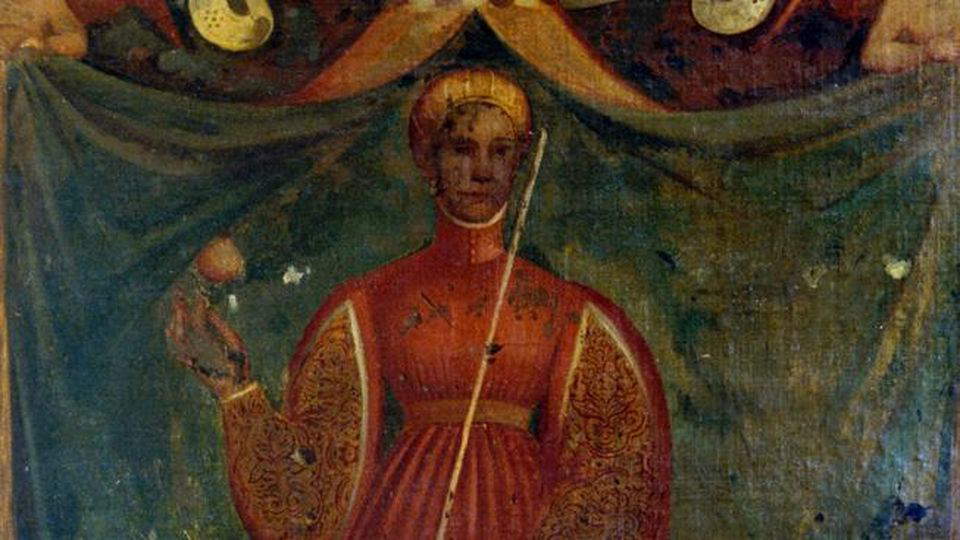 |
| The portrait of Matilda of Canossa in the Castle of Bianello |
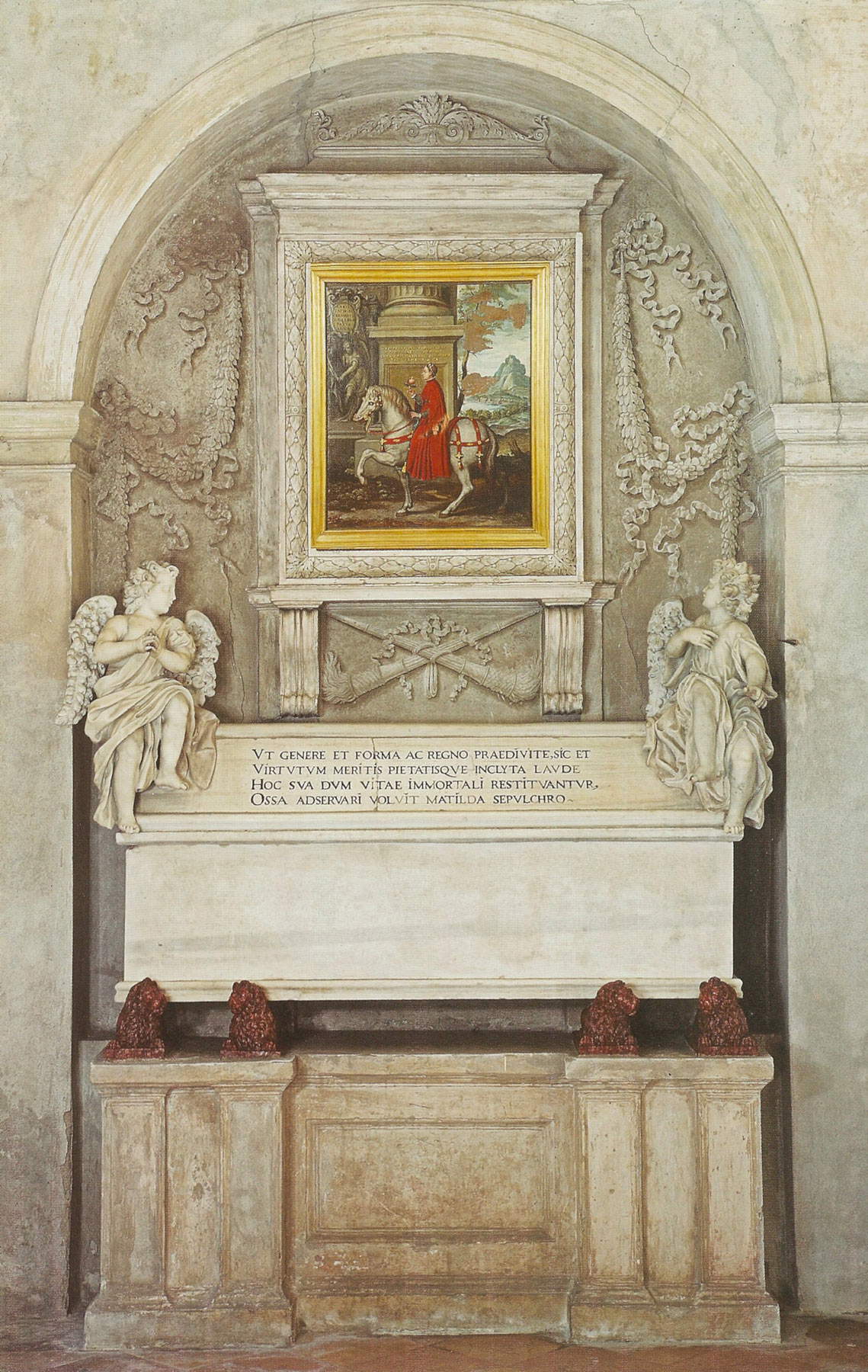 |
| The Famedio of Matilda of Canossa as it was composed in the 16th century (San Benedetto Po, Polirone Monastery) |
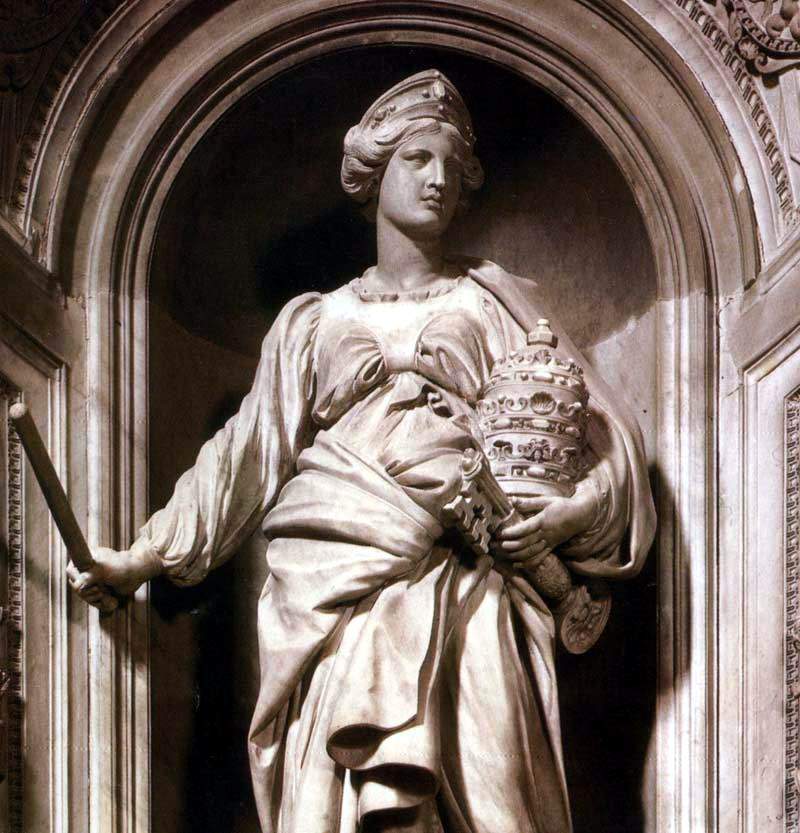 |
| Detail of the statue of Matilda of Canossa in the monument created by Gian Lorenzo Bernini in St. Peter’s at the Vatican |
Finally, in the castle of Carpineti, the countess hosted popes, emperors and politically powerful personalities: in 1077 she welcomed Gregory VII here after the episode of Canossa, and in 1092 an assembly of bishops who intended to continue the fight against Henry IV took place here. Today, part of the original structures of that castle-recinto is still visible: the keep is almost intact and stands out on one of the spurs of the ridge of Mount Antognano; ruins remain of the castle with the quadrangular tower almost intact, except for the top. A small apsidal room was intended for access to the fortification; archaeological excavations have revealed the plan of a small inner church, while outside is the Romanesque church of Sant’Andrea, consecrated in 1117.
It is in the castles of the lands of Canossa that most of the entire existence of one of the most influential women in history is traced, for it was here that the salient episodes of her life took place, her meetings with the emperors and pontiffs of the time; it was here that she cultivated her relationships with the personalities of the time and reflected on her actions that elected her, even centuries later, to a mythical figure of the past. When she died, however, she wished to be buried in the Cluniac model monastery between the Po and the Lirone, to which the countess was very attached and to which she made numerous donations, further underscoring her devotion: a large monument (now empty) was dedicated to her here, rearranged in the sixteenth century by Giulio Romano, on which the countess stands out proudly in a portrait on horseback holding her symbol, the pomegranate.
Essential bibliography
Paolo Golinelli, Matilde di Canossa, Jaca Book, 2015
Donizone, Life of Matilda of Canossa, Paolo Golinelli (ed.), Jaca Book, 2008
Warning: the translation into English of the original Italian article was created using automatic tools. We undertake to review all articles, but we do not guarantee the total absence of inaccuracies in the translation due to the program. You can find the original by clicking on the ITA button. If you find any mistake,please contact us.